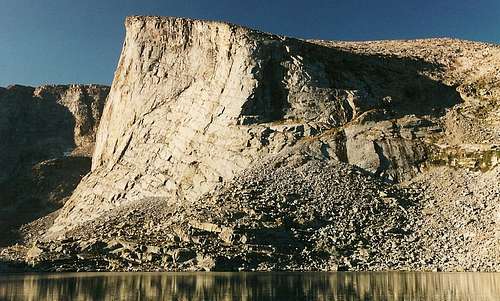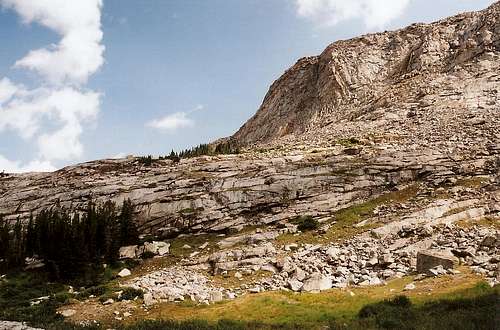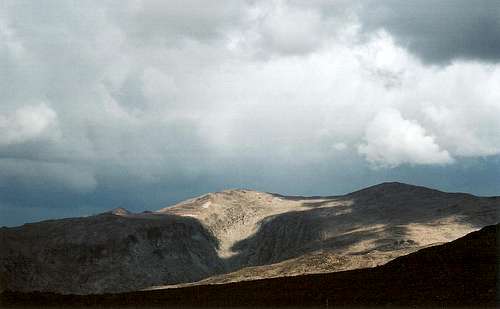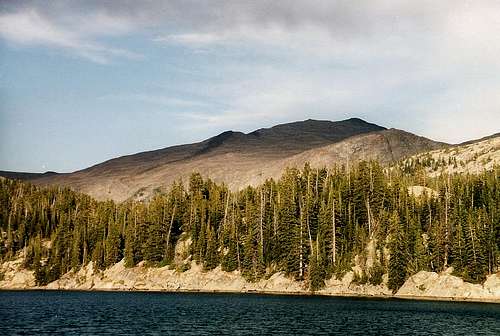A Terrifying Day
All I wanted was to go a little higher and see a little more.
How many of us discovered our love for the mountaintops not because we planned to or because it was something shown or taught to us but rather because curiosity compelled us to see what things looked like “that way,” that way being hidden by the slopes or cliffs flanking our surroundings?
So it was for me, and that urge has rewarded me numerous times and given me more joy and inspiration than has any planned climb or outing, but it has occasionally led to fear and danger, too, as it did this day.
Most SP members have at least one thunderstorm story, a frightening tale of a close call resulting either from our own bad judgment or our own bad luck. I have a handful of such tales. They involved bad judgment and bad luck, but someone or something smiled on me and sprinkled a little good luck over me, too.
The second tale involves only myself, but the first one, this one, involves my wife and the danger into which I unintentionally but foolishly placed her. It is a story about selfishness, guilt, and shame as well. In the end, though, it is about gratitude and relief.
Should’ve Known Better
To get a taste of the Bighorns and get a bit beyond the reach of most day hikers, my wife (Katie) and I decided to set up camp at Mirror Lake in the Cloud Peak Wilderness. Mirror Lake is an easy hike from the West Tensleep Trailhead, and it makes a good base from which to explore the area around the cliff-bound Lost Twin Lakes. Neither of us is much into extended backpacking trips, so we just stayed two nights, enough time to get a feel for the Bighorns, a high granitic range that soars above the plains of north-central Wyoming.
![Lost Twin Lakes]() Lower Lost Twin Lake
Lower Lost Twin Lake
We had already spent three nights in the tiny town of Tensleep and had done some day trips into the canyons and lower peaks of the Bighorns. Each day, there had been thunderstorms, and sometimes the clouding up and the rain had begun before 10 A.M. The day we hiked to Mirror Lake to set up camp, we first sat out a rainstorm before getting out of the car and hitting the trail.
So when Thursday dawned clear for the first time in almost two weeks (we had spent a week in the Absarokas before heading for the Bighorns) and I told myself that the stormy pattern was breaking at last, I should have known better. When we got to Lost Twin Lakes and some small clouds were forming over the ridges and I told myself that it was probably no big deal, I should have known better.
![Bighorn Mountains]() Near the start of the off-trail journey-- still early, but I should have listened to what these clouds were whispering.
Near the start of the off-trail journey-- still early, but I should have listened to what these clouds were whispering.
Actually, I did know better, but that bug to explore and go higher had infected me already. Dramatic as the setting of Lost Twin Lakes was, I felt confined by the cliffs, and I just had to see what lay on the other side. North of the lake basin, a drainage led up above treeline and to the high country beyond, and it was there I wanted to go.
When that bug seizes me, I can rarely resist it. Usually, I am alone when this occurs, but even when Katie is with me, she usually stays back and waits for me to return. This time, though, I succeeded in convincing her to go up. All my raving about the wonders of the off-trail, mountaintop world sparked her sense of adventure, and up she went.
The problem, and this is a problem I made for myself and which I made worse by ignoring, was that I was ascending much faster than Katie was, and, instead of doing the right thing and waiting for her or at least slowing down enough for us to keep visual contact at all times, I kept moving at my own pace.
Clouds began moving in as I climbed higher, and it was obvious that a storm was coming. But I was close to what seemed to be the crest of a ridge, and, knowing I could easily make it there before the storm could, I determined to reach it.
I found my views far across that other side and deep into the Cloud Peak Wilderness, but I also found that the ridge led to a nearby peak, little more than a huge rubble pile but a peak nonetheless. By this time, winds were picking up and the skies were mostly dark, but I still figured I had time to make the summit.
What followed was both beautiful and amazing, though I admit it was stupid of me to have been there to behold it. As I followed the ridgeline to the summit of what I now call “Storm Shelter Mountain” even though its name is Peak Angeline, the valleys on either side of me filled with rain, thunder, and lightning. I was actually looking
down on a storm (or, in this case, storms) while a sliver of open sky clung above me and led me to the top of the mountain. It was no longer a quest for solitude or better views; instead, it was an ego-driven battle with Nature-- was I faster than the storm?
![Bighorn Mountains]() What I was racing
What I was racing
I won that battle, I suppose, but time and reflection have told me that my victory was more like the “victory” one achieves when an agitated bear knocks him down, paws at him, and ultimately walks away without inflicting lethal harm-- maybe you won that hand, but you wouldn’t want to play it again, and you can’t escape the notion that your adversary
let you win.
Yes, I made the summit, and I even had a few minutes to sit there and relish it, but the mountain didn’t let me go so easily. Just minutes after I left the top, the storm raged in, and I had to make a decision.
Conventional wisdom dictates the following when one is caught in a lightning storm in the wilderness: 1) seek shelter in a stand of trees of uniform height or 2) if the first option is unavailable, crouch as low as possible, head bent down, with only the rubber soles of your shoes contacting the ground. Well, that first option was unavailable, and I frankly did not and do not have the nerve to endure the second. I suppose a third option is to run like hell, but that’s not supposed to be such a smart move, either.
Instead, I sought shelter in a pseudo-cave formed by the boulders characteristic of the ridges and summits of this area of the range. I have read that what I did is not a good course of action, either, but tell that to someone who is caught at around 12,000’ with lightning crashing around him so close by that there is almost no pause between the flash and the boom. No, I think most people would do what I did.
I sat out the storm, which lasted almost an hour and dumped hail and snow pellets across the mountains, shivering as the cold seeped through my gloves, jacket, and pants (fortunately, I at least knew how to dress and pack for the mountains). My shelter kept me mostly dry, but some of the snow pellets found a way through the rock piles and settled on me as a final resting place as I hoped that this spot wouldn’t become
mine. Still, I couldn't help but admire the power of the storm and its beautiful sounds.
When the lightning was gone, the thunder distant, and the snow pellets just an amusing sight for an August day in Wyoming, I emerged from my den. Throughout the ordeal, I had been wondering and worrying about Katie, but now, with the immediate danger to myself past, I felt a deep dread-- Where was she when the storm hit? Where had she gone? All I knew were the following: she had been above timberline when I last saw her, she had little experience with mountain storms, and, because she had been so far behind and below me, she would have had no idea about what was coming until it was upon her.
Absolute Loss
Who among those who have been married hasn’t made a gratuitous joke at his or her spouse’s expense? Who hasn’t offered some wry comment about how grand life would be if those days of freedom were to return?
Who hasn’t heard the old idiom about being careful what you wish for?
As quickly as I could, I descended the now-slippery slopes back to the trees around Lost Twin Lakes, hoping and praying I would find Katie there huddled in a nice stand of uniformly high trees. I searched and called.
No Katie.
I went back up, all the way back to the summit ridge, calling Katie’s name.
Nothing.
Back to the trees, calling and searching again, back up, this time looking for a crumpled pile the same color as Katie’s jacket.
Still nothing.
Somewhere among the cold rocks of a remote area of the Bighorns, my wife had been struck and killed by lightning, I believed, and it was all my fault.
Reason to Believe
![Weidemeyer s Admiral]() A sign of hope-- life in the wake of destruction
A sign of hope-- life in the wake of destruction
Back near the lakes, I saw a butterfly-- a Weidemeyer’s Admiral-- resting on a rock, wings spread, drying out in the returning afternoon sun. Taking this as a sign of hope (and taking a picture, too-- sorry, but tragedy can’t kill beauty), I decided I had to head for camp, pack up a few necessities, and then hike back to the trailhead, hopefully in time to get help before night could fall.
On the trail, I arranged some rocks to form a
B and an arrow pointing back to camp just in case Katie was still out there and behind me, and I took off. Leaving that area when I believed that my dead or dying wife was out there was perhaps the most difficult thing I have ever done, but I tried to remember the symbolism of that butterfly-- that beauty and hope can survive despite the overwhelming power of the forces bent on destroying it.
![Peak Angeline]() "Storm Shelter Mountain" from Mirror Lake a few hours after the storm
"Storm Shelter Mountain" from Mirror Lake a few hours after the storm
Katie was at camp. When the storm struck, she had initially tried to find shelter among the trees. The cover had been thin, though, and she was getting soaked, so she decided to head back for the shelter of our tent. I felt mad at first-- I never would have done that and left my partner wondering about my whereabouts-- but then I remembered another old saying, this one about the pot calling the kettle black.
I kept my mouth shut, and we embraced. If I’ve ever experienced one more honest, I don’t remember it. And that is as much as you need to know about the rest of that day.
![Mirror Lake, Dawn]() Renewal-- sunrise the next day
Renewal-- sunrise the next dayP.S.
You’d be excused if, after reading this and my
Jackson Glacier TR, you think I might be the worst hiking and climbing partner in the world. All I can say is that I’ve learned from those experiences. I’ll put
myself at risk, and you can fairly argue that
that is a foolish and selfish thing for a husband and a father of three to do, but to the extent that it's within my ability to control, I won’t again knowingly or intentionally put someone else at risk in the wilderness.










Comments
Post a Comment